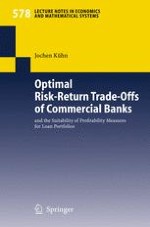1.1 Problem Statement and Research Question Active loan portfolio management is becoming more and more imp- tant. In the year 2004, European banks sold credits worth EUR 249 billion. Big deals were made by the German banks Hypo Real Estate (EUR 3.6 billion) and Dresdner Bank (EUR 1.2 billion). In addition, credit exchanges were established which made loans more liquid. For example, in October 2004 the German “Deutsche Kredit-B¨ orse” was established, which focuses on trading loans assigned to medium-size businesses. It is empirically shown that active loan portfolio management can 1 be very pro?table. However, a precondition to bene?t from active loan portfolio management is having knowledge about valuating loan po- folios. Shareholders can steadily bene?t from such transactions only if banks valuate loan portfolios correctly. This is this dissertation’s mo- vation for dealing with pro?tability measures for loan portfolios. Nowadays, banks measure the pro?tability of loan portfolios p- marily by calculating the return on risk adjusted capital (RORAC). Here return is the expected pro?t after re?nancing and operational costs. Risk adjusted capital, more frequently called economic capital, istheamountofequitywhichmustbeheldtoguaranteeacertaingiven solvency level of the bank. However, calculating this ratio is not su?cient when valuating loan portfolios. The calculation of economic capital implies that the bank 1 See Cebenoyan and Strahan (2004). 2 1 Introduction already knows which solvency level is optimal. It also presumes that the optimal solvency level is independent of the risk-return pro?le of the loan portfolio. But this need not be true.
